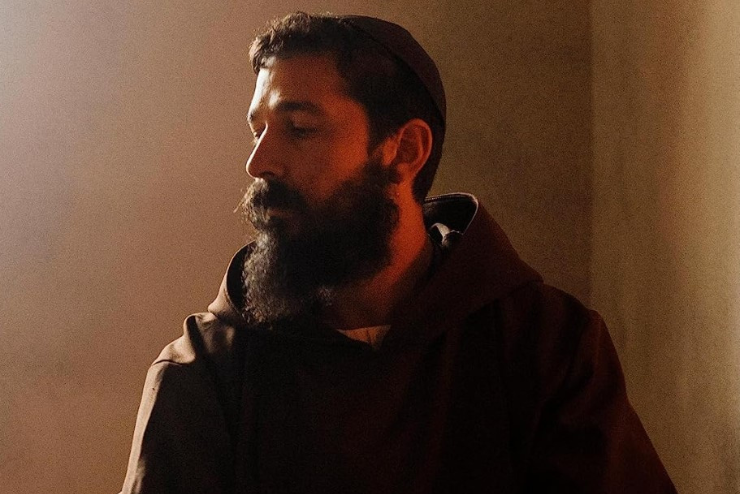Directed by Abel Ferrara ◆ Screenplay by Abel
Ferrara and Maurizio Braucci ◆ Produced by
Interlinea Film ◆ Distributed by Gravitas Ventures
It is a difficult task for any film director to make a biopic. There will always be room for criticism because of something that was missed or misrepresented. In the case of Abel Ferrara’s new film about the 20th-century saint and stigmatist Padre Pio, many viewers (especially Catholic ones) will be left wanting a deeper story. Ferrara’s attempt at capturing the life of Italian Capuchin friar (played by Shia LaBeouf) should not be disparaged, but his odd cinematic choices demystify and minimize the spiritual power Padre Pio is known for.
Set against the historical backdrop of World War I and the rise of Marxist ideas, Ferrara’s film portrays socialism as the best economic option available to the Italian people following the end of the war. Although Italian laborers may have been mistreated by landowners under the prewar capitalistic system, Ferrara’s screenplay pushes a political agenda that goes beyond historical accuracy. His simplistic narrative of good-guy socialists versus bad-guy capitalists, played out in stilted and wooden dialogue between the revolutionaries and the landowners, renders the film dull and occasionally silly. The film constantly reminds the audience that its real preoccupation is communism, not Christianity.
Despite being the titular focus of the film, Padre Pio is portrayed in a superficial way, almost as an incidental figure to the political struggle of the plot, and the film ends without telling its audience who he was and why we should care. No one expected the idiosyncratic Ferrara to make a straightforward birth-to-death biopic, but he might have creatively focused on a few aspects of Pio’s life to make a poignant and powerful impression.
Pio was a controversial figure within the Catholic Church during his lifetime, and stories of his bouts of ecstasy and the miraculous stigmata on his hands and feet were initially regarded with suspicion by the hierarchy. He was a renowned confessor who seemed to have supernatural insight into souls, and was said to have been blessed with other miraculous gifts, including bilocation, healing, and prophecy.
Of these memorable spiritual events in Pio’s life, only one makes it into the film: an account in which Pio said he literally fought the devil in his cell, and emerged with real physical bruises. Other scenes are memorable but also provocative, such as one in which Pio is tempted by a nude, voluptuous woman, and another in which a man confesses twisted sexual feelings for his adolescent daughter. In some scenes Pio screams and curses at insincere penitents. Though the real Pio could be harsh with sinners and would sometimes raise his voice in anger, he was never known to use foul language.
Ferrara is known to be a subversive film director, and he felt free to develop these scenes in his own particular fashion. Certainly, having the female actress Asia Argento (daughter of the famous Italian director, Dario Argento) play the perverted father was an interesting choice.
But ultimately all of Ferrara’s artistic flourishes fall flat because the film does not have the theological or mystical depth required to be either religious or subversive. We know from Mel Gibson’s 2004 The Passion of the Christ that a great religious artistic vision can show the profane and the vulgar in a deep way, while still affirming the sacred. And Martin Scorsese’s 1988 film The Last Temptation of Christ reinterpreted the Gospels and the nature of Christ’s humanity in a way that was at least interesting, even if many Christians found it disturbing and subversive. Ferrara’s film contains no real religious message for the viewer; it is unfortunately nothing more than an uninspiring representation of political struggle in post-World War I Italy.
LaBeouf took the role of Pio very seriously, even if Ferrara didn’t. In fact, making Padre Pio led LaBeouf to convert to Catholicism. He described much of this experience in an hour-and-a-half interview on YouTube with Bishop Robert Barron, which is far more intriguing than Ferrara’s film of roughly the same length. I’m always skeptical when Hollywood stars claim any kind of conversion, but judging from the conversation with Bishop Barron, LaBeouf appears to be quite genuine about his faith.
LaBeouf obviously sought a sense of spiritual purpose. In his prior life he was trying to fill himself with earthly things, which never fulfilled his yearning for God. In John 19:28 we read that “Jesus knowing that all things were now accomplished, that the scripture might be fulfilled, saith, ‘I thirst.’” This verse speaks to human longings for the sacred. Speaking to God, Augustine famously wrote in his Confessions, “Our hearts are restless till they find rest in Thee.”
Although Ferrara’s film is not high art, its making accomplished something by leading LaBeouf onto a redemptive path.
(Chronicles Executive Editor Edward Welsch contributed to this article.)

Leave a Reply